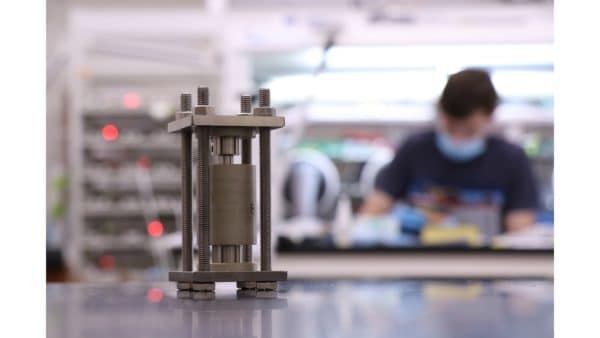The U.S. Navy and the Ameresco Federal Solutions are expanding on-site generation at Norfolk Naval Shipyard in Portsmouth, Virginia.
This $173 million project includes a 19 MW combined heat and power plant, a 3 MW battery energy storage system, and a microgrid control system that will help reduce the amount of electricity imported from the grid by 68%.
Over the course of the 22-year performance period following construction, the project is guaranteed to generate more than $411 million in cost savings.
As part of the project scope, Ameresco will refurbish existing backup power assets, integrate them into the microgrid, and upgrade the electric distribution system to provide redundant sources of supply.
The project also features a new industrial wastewater treatment plant. After construction is completed in 2022, Ameresco will operate and maintain the CHP plant, water treatment plant, and microgrid until January 2044. Each measure is designed to operate in compliance with relevant Department of Defense and Navy cybersecurity requirements.
Big errors in urban GHG data
Researchers from Northern Arizona University report finding what they said is a systematic under-reporting of urban emissions by cities. The under-reporting is important as cities take a range of steps to reduce their emissions.
The researchers said that urban areas produce almost 70% of greenhouse gas emissions, and that many cities currently produce their own inventories detailing those emissions.

Image: Wikimedia Commons/alexeatswhales
As part of their work, the researchers, who are from the university’s School of Informatics, Computing, and Cyber Systems, compared 48 self-reported inventories from cities–including New York, Chicago, Los Angeles, Dallas, Denver, and Philadelphia–against a standardized system for quantifying greenhouse gas emissions known as Vulcan.
They found large differences that varied widely from one city to the next. When averaged, the self-reported emissions were almost 20% below the emissions estimated by the standardized Vulcan system. At the extremes, for example, Cleveland, Ohio, reported emissions 90.1% below the Vulcan estimate. Palo Alto, Calif., reported emissions 41.7% greater than the Vulcan estimate.
The researchers said that in order to prioritize and track emission reductions, cities will need an unbiased understanding of their emissions.
They said that Indianapolis aims to make a 20% reduction in greenhouse gas emissions from buildings by 2025 relative to 2016 values. But with the greater than 25% underestimate reported in the study, the researchers said it will be hard to track progress toward this target, or know when and if it has been achieved.
The approach taken by the research team used a consistent method across all cities and combined federal, state, and local data systematically. Data from the Vulcan project are available on the Oak Ridge National Laboratory Data Archive.
Detailed look at Li-ion battery cycling
A research team recently observed what they described as the internal evolution of materials inside solid-state lithium batteries. They watched as the li-ion batteries were charged and discharged.
The researchers said the detailed 3D information that resulted may help improve battery reliability and performance by replacing flammable liquid electrolytes in existing lithium-ion batteries with solid materials.

Image: Matthew McDowell, Georgia Tech
Despite worldwide use of lithium batteries, the exact dynamics of their operation has been elusive. Using a small (roughly two millimeters wide) cylindrical battery, researchers working at Argonne National Laboratory captured 3D images of structural changes during the battery charge and discharge cycles.
The images showed how the changes of electrode materials at lithium/solid-electrolyte interfaces determine the behavior of solid-state batteries. The researchers found that battery operation caused tiny voids — resolved up to 1-2 microns in size, about 50 times smaller than the width of a human hair — to form at the interface. This action created a loss of contact that was the primary cause of cell failure.
Lithium-ion batteries currently rely on a liquid electrolyte to carry ions back and forth between electrodes within the battery during charge and discharge cycles. The liquid coats the electrodes, allowing free movement of the ions.
Rapidly evolving solid state battery technology uses a solid electrolyte instead of a liquid one. The switch to a solid electrolyte could boost energy density and improve safety. But removing lithium from electrodes can create voids at interfaces and cause reliability issues that limit how long the batteries can operate.
To counter this, the researchers suggest creating structured interfaces through different deposition processes to try to maintain contact through the cycling process. Their research was reported in the journal Nature Materials.
This content is protected by copyright and may not be reused. If you want to cooperate with us and would like to reuse some of our content, please contact: editors@pv-magazine.com.









By submitting this form you agree to pv magazine using your data for the purposes of publishing your comment.
Your personal data will only be disclosed or otherwise transmitted to third parties for the purposes of spam filtering or if this is necessary for technical maintenance of the website. Any other transfer to third parties will not take place unless this is justified on the basis of applicable data protection regulations or if pv magazine is legally obliged to do so.
You may revoke this consent at any time with effect for the future, in which case your personal data will be deleted immediately. Otherwise, your data will be deleted if pv magazine has processed your request or the purpose of data storage is fulfilled.
Further information on data privacy can be found in our Data Protection Policy.